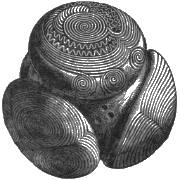Canmore Site 47802: KINNEIL MILL - MUIRAVONSIDE - CIST(S) (BRONZE AGE), CREMATION CEMETERY (BRONZE AGE)
Description
| Site Name | KINNEIL MILL |
|---|---|
| Other Name(s) | n/a |
| Site Number | NS97NE 24 |
| Broad Class | RELIGIOUS RITUAL AND FUNERARY |
| Site Type(s) | CIST(S) (BRONZE AGE), CREMATION CEMETERY (BRONZE AGE) |
| NGR | NS 9745 7820 |
| NGR accuracy | NGR given to the nearest 10m |
| Local Authority | FALKIRK |
| Parish | MUIRAVONSIDE |
| Record created | 1990-08-08 |
| Last updated | 2000-04-12 |
Archaeology Notes
NS97NE 24 9745 7820.
The NSA records the discovery of a cist at Castle Hill.
NSA 1845 (J M'Farlan); RCAHMS 1963
NS 9745 7820. Gravel-quarrying E of Castle Hill revealed two short cists with inhumations, one also containing an undecorated food vessel, in the position shown on plan 1. Subsequent quarrying made it impossible to fix their position accurately, but their site was pointed out by the digger driver concerned. The site was visited by A S Henshall and P R Ritchie, who recovered the remains of 7 cinerary urns, and sections of two ditches were noted. Excavations were carried out later in 1965, showing that the W ditch was apparently circular in form, enclosing an area 25' - 35' in diameter, the ditch itself varying between 5' and 6'9" wide by c.2' deep. Finds made were as shown on plan 2; they included an eighth cinerary urn, which projected slightly above the ancient soil surface, suggesting that the enclosure had been covered with a protecting layer in the form of a cairn or barrow. The topsoil removed by the quarry company did not show a higher than average proportion of stones. The ditch silt was almost entirely sand, which could mean that the area within the ditch had been covered with the sand and gravel dug from the ditch and that the barrow had weathered away and been ploughed out.
The cists mentioned earlier were found about 120' E of the cremation cemetery, and the eastern ditch, 105' ENE of the cemetery may have been associated with them, though it was impossible to determine the precise relationship. This second ditch was 8'6" wide x 3' deep.
Among other finds was a bone toggle with four perforations which came from urn 1. A broken four-hole specimen has been found with a cremation associated with a bronze blade and a bone crutch-headed pin at Rahinashurock, Co. Westmeath. Crutch-headed pins may be dated by their Wessex culture contexts, mainly belonging to its second phase. All finds from the excavation are in the National Museum of Antiquities of Scotland (NMAS accession nos: EQ 751-763).
J W Marriott 1969
Finds from Kinneil Mill sand quarry which were found in 1965 and donated to the NMAS comprised: (Acc No: EQ 750) An undecorated food vessel; (EQ 751-2) cordoned cinerary urns; (EQ 753) bone toggle; (EQ 754-8) fragments of collared cinerary urns; (EQ 759-60) urn wall sherds; (EQ 761) medieval jar sherd; (EQ 762) piece of lignite; and (EQ 763) half of a sandstone ring, c.1 1/4" in diameter.
Proc Soc Antiq Scot 1967; NMAS Accessions Index
This site may be connected with the enclosures just to the south -NS97NE
Information from RCAHMS (CAA) January 1988.
Identifiers and Links to Other Records
This record has no links! Would you like to help?
| Identifier / External Link | Linked Record | Status | Comment |
|---|---|---|---|
| Canmore Site Number (legacy): NS97NE 24 | No linked record |
This area is visible only to logged in users.
